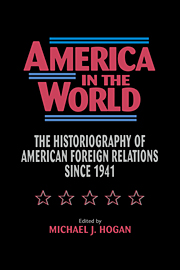Book contents
- Frontmatter
- Contents
- Preface
- The Authors
- Part One The State of the Art
- Part Two The Historiography of American Foreign Relations since 1941
- 6 The Historiography of American Foreign Relations: An Introduction
- 7 A Half-Century of Conflict: Interpretations of U.S. World War II Diplomacy
- 8 The Decision to Use the Bomb: A Historiographical Update
- 9 Origins of the Cold War in Europe and the Near East: Recent Historiography and the National Security Imperative
- 10 Making Known the Unknown War: Policy Analysis of the Korean Conflict since the Early 1980s
- 11 Eisenhower Revisionism: The Scholarly Debate
- 12 John F. Kennedy as World Leader: A Perspective on the Literature
- 13 The Unending Debate: Historians and the Vietnam War
- 14 Complaints, Self-Justifications, and Analysis: The Historiography of American Foreign Relations since 1969
- 15 An Emerging Synthesis? U.S.–Latin American Relations since the Second World War
- 16 Gideon's Band: America and the Middle East since 1945
- 17 The Cold War in Asia: The Elusive Synthesis
- 18 The Power of Money: The Historiography of American Economic Diplomacy
- 19 Coming in from the Cold War: The Historiography of American Intelligence, 1945–1990
- Index
15 - An Emerging Synthesis? U.S.–Latin American Relations since the Second World War
Published online by Cambridge University Press: 05 June 2012
- Frontmatter
- Contents
- Preface
- The Authors
- Part One The State of the Art
- Part Two The Historiography of American Foreign Relations since 1941
- 6 The Historiography of American Foreign Relations: An Introduction
- 7 A Half-Century of Conflict: Interpretations of U.S. World War II Diplomacy
- 8 The Decision to Use the Bomb: A Historiographical Update
- 9 Origins of the Cold War in Europe and the Near East: Recent Historiography and the National Security Imperative
- 10 Making Known the Unknown War: Policy Analysis of the Korean Conflict since the Early 1980s
- 11 Eisenhower Revisionism: The Scholarly Debate
- 12 John F. Kennedy as World Leader: A Perspective on the Literature
- 13 The Unending Debate: Historians and the Vietnam War
- 14 Complaints, Self-Justifications, and Analysis: The Historiography of American Foreign Relations since 1969
- 15 An Emerging Synthesis? U.S.–Latin American Relations since the Second World War
- 16 Gideon's Band: America and the Middle East since 1945
- 17 The Cold War in Asia: The Elusive Synthesis
- 18 The Power of Money: The Historiography of American Economic Diplomacy
- 19 Coming in from the Cold War: The Historiography of American Intelligence, 1945–1990
- Index
Summary
Though often overshadowed by other topics in the course of then Cold War, the subject of U.S. relations with Latin America since the Second World War has retained a compelling interest. Since the publication in 1981 of Richard V. Salisbury's historiographical essay, “Good Neighbors? The United States and Latin America in the Twentieth Century,” a wide assortment of studies have advanced the thresholds of knowledge and understanding in this field. This body of scholarship to an extent still manifests one of the attributes identified by Salisbury as a characteristic – that is, an eclecticism of approach and interpretation. Dominated by the monograph, narrowly focused, and largely dependent upon the records of the United States, the literature shows the effects of fragmentation. No commonly conceived synthesis is presently in ascendance. Nevertheless, the persistent influence of scholarly investigations characterized by Salisbury as revisionist suggests the possibility of constructing integrative accounts on the basis of radical perspectives. At the same time, countervailing impulses also exist, especially in those works seeking to appraise current trends and circumstances, emphasizing the growth of democratization and free enterprise practices.
This essay assesses the principal historiographical tendencies in the study of U.S.-Latin American relations in recent times. Though admittedly selective, my choice of titles includes studies in English by historians and some by social scientists, journalists, and diplomats. When confronted with the outpouring of books and articles on Central America in the 1980s, I decided to exclude most commentaries on contemporary events in order to focus on publications of more enduring consequence by and for historians.
- Type
- Chapter
- Information
- America in the WorldThe Historiography of US Foreign Relations since 1941, pp. 424 - 461Publisher: Cambridge University PressPrint publication year: 1996
- 1
- Cited by



